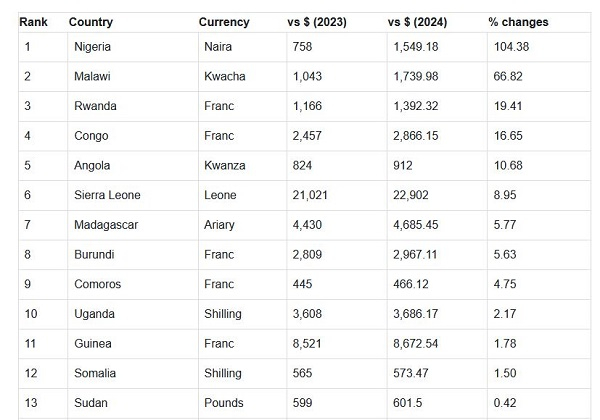Over the past year, some African nations have improved the performance of their currencies against the US dollar while others continue to face challenges.
The challenges faced by African currencies include persistent trade imbalances, high inflation, political instability, and dwindling foreign reserves, which lead to depreciation.
Other challenges faced by some African nations in stabilizing their currencies include persistent inflation, high debt levels, and political instability.
These issues undermine efforts to achieve sustainable exchange rate improvements.
Exchange rates significantly impact a country’s inflation and the purchasing power of its currency.
A sharp depreciation can drive higher inflation by raising the cost of imported goods and services, placing additional strain on consumers and the economy.
As of August 1, 2023, Statista data revealed the performance of various African currencies against the US dollar.
The U.S. dollar’s status as a reserve currency, its role in international trade, and the stability of the U.S. economy makes it the most widely used benchmark for exchange rates worldwide.
Sierra Leone’s Leone had the highest exchange rate, with one dollar equaling 21,021.7 leones, marking it as the continent’s weakest currency.
It was followed by the Guinea Franc, which traded at 8,521 to the dollar, and the Malagasy Ariary, at 4,430.
The same data showed that one dollar was equivalent to 758.9 Nigerian Naira, 824 Angolan Kwaza, 599 Sudanese Pounds, 185 Liberian Dollar, 4.77 Libyan Dinar, 11 Ghanaian Cedi and 30.85 Egyptian Pounds highlighting the diversity in currency strength across the continent.
Recently, some nations have overcome inflationary pressures, strengthening their currencies, while others have faced steep fluctuations and worsening exchange rates.
The table below compares the dollar exchange rates of the worst-performing currencies in 2023 and December 31, 2024;


Nigeria’s Naira saw the steepest depreciation at 104.38%, followed by Malawi’s Kwacha at 66.82%, reflecting significant economic challenges.
A key factor in the naira’s decline was the Central Bank of Nigeria’s (CBN) decision to liberalize the foreign exchange market in June 2023.
While aimed at unifying exchange rates and attracting investment, the policy also introduced volatility, increasing pressure on the currency.
Rwanda and Congo also experienced double-digit declines of 19.41% and 16.65%, respectively, highlighting regional economic pressures.
Moderate changes were observed in Angola, Sierra Leone, Madagascar, and Burundi, where currency depreciations ranged from 5.63% to 10.68%.
Comoros, Uganda, and Guinea recorded smaller declines under 5%, suggesting relative stability. Notably, Liberia’s Dollar and Tanzania’s Shilling appreciated slightly, showcasing resilience in their exchange rate performance.
These trends reflect varied economic conditions across the continent, with some currencies showing stability while others experiencing severe depreciation.
This highlights the critical role of sound fiscal and monetary policies in mitigating exchange rate volatility and strengthening economic resilience.
Watch the latest edition of BizTech below:



